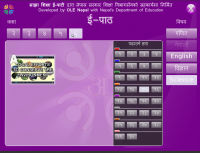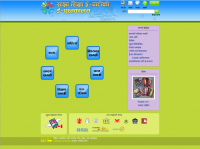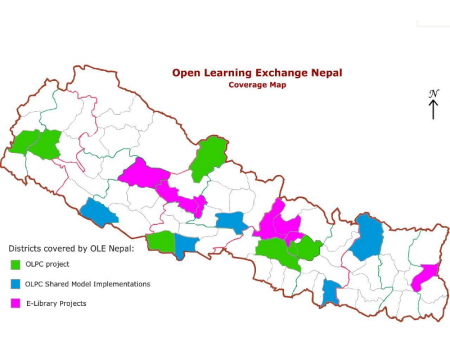OLE Nepal
Open Learning Exchange Nepal
Open Learning Exchange Nepal (OLE Nepal) is a social benefit organization with a mission to increase access to quality education through the integration of technology. OLE Nepal has been working since 2007 to use innovations in technology to improve education quality and access in rural public schools in the country with the belief that inexpensive computers are in the long-term the most cost-effective medium for increasing access to education for Nepali children. The organization aims to increase the quality of education through the creation of open-source learning activities combined with teacher training.
OLE Nepal's program is currently running in fifty schools in sixteen districts in various forms in partnership with Nepal Government's Department of Education (DoE) with support from development partners including Danish Government’s Local Grant Authority, United Nations World Food Programme (WFP) and Finnish Government’s Funds for Local Cooperation.
OLE Nepal and Nepal's DoE recently started the implementation of OLPC shared-model in fifteen schools in three new districts based on the review of the program and the feedback received from teachers and schools as well as the lessons learned over the past three years. In the shared-model, students from different classes share a set of laptops but each student has one-to-one access to laptops and digital resources when a particular class is using the laptops. In addition to significant cost savings, this model makes it is easier for schools and teachers to manage the programs.
OLE Nepal resources
- OLE Nepal Home
- OLE Nepal Projects on Redmine project management tool (user account needed)
- OLE Nepal Deployment Guide
- OLE Nepal Presentation at 1cc - Rabi Karmacharya came to Boston to share insights on what's been happening in Nepal so far.
- More about the OLE Nepal Community.
- OLE Nepal Blog which is pretty darn active
- Mailing list for OLPC in Nepal
- OLE Nepal IRC chatroom: #olenepal (http://webchat.freenode.net/)
- How you can get involved
History
In early 2007, Rabi Karmacharya and Bryan Berry, decided to leave their jobs in the technology sector and join force to launch OLE Nepal with the vision of transforming Nepal’s public education system using technology in the classroom teaching-learning process. Prior to that, the two had been part of a group of volunteers who had been meeting and discussing the possibility of leveraging the One Laptop Per Child (OLPC) laptops to address the challenges faced by educators in the country. They met and discussed with various educators, teachers, experts, activists, community leaders, donors, and government officials going on to form the Board of Directors, and registering the organization. In the process, they received much support from Mr. Mahabir Pun, who also believed in their common cause. Dr. Saurav Dev Bhatta also joined as one of the founding members when the organization was officially launched in September 2007.
OLE Nepal’s mission is to provide freely accessible high-quality interactive teaching-learning materials along with an education-centered digital library that addressed the problems of quality, access, and disparity in education. OLE Nepal signed an agreement with the Government of Nepal to help implement Nepal's pilot of OLPC in 2008 and then carried out a test phase in Bashuki and Bishwamitra Schools. The agreement has been renewed in subsequent years to expand the technology-based education in more schools and grades.
Current Projects
OLE Nepal’s ICT-based education programs are currently running in 50 schools in 16 districts across Nepal benefitting more than 10,000 students. OLE Nepal has also trained over 300 school teachers on how to integrate technology in classroom teaching/learning process. OLE Nepal has prepared an extensive collection of interactive digital learning materials that are based on the school curricula. OLE Nepal has also developed a digital library that are installed in servers in each school.
The introduction of laptops to students and teachers are accompanied by the following activities:
- Development and distribution of free and open digital educational content
- Preparing teachers on effective integration of ICT in classroom teaching
- Research and development of appropriate technology and network infrastructure
- Capacity development
Digital Content
OLE Nepal has developed two types of digital content: E-Paath and E-Pustakalaya.
E-Paath

E-Paath is a collection of subject-specific, and grade-specific digital learning materials that are conceptualized by educators and curriculum experts. These interactive educational software modules are closely aligned with the national curriculum and are designed to help teachers and students meet the learning objectives outlined in the curriculum. These activities employ various features of technology such as audio, images, animation and text to help students better understand concepts in various subjects.
Each activity has an accompanying “Teacher’s Note” that explains how teachers can integrate the activity in classroom teaching, including the curriculum objectives, learning areas, corresponding textbook chapter, and how the digital activity can be used alongside other learning tools inside and outside the classroom.
E-Pustakalaya

E-Pustakalaya (Go to E-Pustakalaya) is an education-centered digital library containing full-text documents, books, educationational videos, audio books, and interactive educational software that can be freely accessed through an intranet or on the Internet. OLE Nepal started the development of E-Pustakalaya with the aim to improve children’s reading skills and develop a reading culture in schools by giving them free and open access to age-appropriate reading materials.
Users of E-Pustakalaya can browse through various sections looking for items they like, or they can search for specific items based on full or partial author name, title, publisher and/or keywords. Users can read books and documents, view videos, listen to audio clips, play educational games directly from E-Pustakalaya, and in the case of books and documents, download and store for later viewing. The E-Pustakalaya currently holds more than 4000 titles.
While these resources can be accessed online , OLE Nepal has placed special emphasis on making them available in far flung schools that do not have Internet connectivity. E-Pustakalaya is hosted in low-cost low-power servers and installed in schools and community libraries that either do not have Internet connectivity or have low bandwidth connection.
Teacher Training
OLE Nepal has developed and delivered training programs to help teachers integrate laptops and digital learning materials in classroom teaching.Teachers receive an eight-day training before the deployment of computers in schools. They take part in discussions and practice teaching to build both their skills and confidence in using digital resources in their class. In-School Training is used as a monitoring tool to observe how much the teachers are using the integration of ICT in classroom teaching and what issues they have while doing so. This is conducted 4-6 weeks after the teacher training mentioned above. Refresher Training are organised to help teachers to revise what they learnt in previous training. This project also gives opportunity for teachers to share their issues and lessons learned. For OLE Nepal, it is an evaluation tool to review how effective the trainings were and what training strategies or content need to be reviewed.
Technology and Infrastructure
OLE Nepal constantly seeks to utilize the best possible technology solution to implement ICT-based education in under-resourced rural schools. On the hardware front, it uses low-power, low-cost, durable equipment that is readily available and easily serviceable locally. With operating system and software applications, OLE Nepal advocates for open source solutions not only because of cost considerations, but also for ease of customization and localization, which are essential in the development and distribution of effective educational content.
Capacity Building
OLE Nepal has worked in partnership with various central and local level agencies within the Ministry of Education system to ensure that they build the necessary institutional capacity to implement ICT-based Education on a national level. The project has gained tremendously from the inputs provided by government trainers, curriculum experts, district level school supervisors, resource persons and teachers. The OLPC project was implemented in partnership with the Department of Education and the District Education Offices in the program districts. The DoE and OLE Nepal has also worked together to promote awareness about ICT-based Education. Teacher trainings have been conducted with help of government trainers who were prepared in providing ICT-based Education training. OLE Nepal has consulted with subject experts from the Curriculum Development Center in the preparation and review of the E-Paath activities. All in all, OLE Nepal opts to work with and empower existing resources within our public education system instead of creating a parallel system.
Deployment
OLE Nepal has deployed over 4000 laptops to 50 schools in 16 districts in Nepal as of August 1, 2012 (Project Coverage). XO Laptops were installed with interactive learning activities including E-Paath, and distributed to classes 2, 3, 4, 5 and 6.
Complete information on sites can be found on OLE's deployment sites page of the Redmine project management tool.
Schools By district:
- Banke
- Baglung
- Dhadeldhura
- Dhanusha
- Doti
- Kavre
- Kapilvastu
- Lalitpur
- Mustang
- Makwanpur
- Rupandehi
- Solukhumbu
- Syangja
- Tanahu

